Arguably less famous than its neighbour to the West, Umbria is nevertheless a joy to visit, with a plethora of stunning hilltop towns, fascinating cities and incredibly beautiful villages to explore. Enjoy our A to Z of the region’s towns, villages and cities, to help you plan your next holiday in Umbria.
Amelia
Amelia is a delightful hilltop town overlooking the River Tiber. Access is through one of the four original Roman gates, the main one being the Porta Romana. According to some historians, it is also the oldest town in Umbria.
Arrone
Arrone is a fortress village in the Valnerina valley in the South East of Umbria and another village in Umbria which has earned the name of the ‘borghi piu belli d’Italia.’ The village is perched on a rocky outcrop and its location means that it is often visited by sports enthuiasts who make the most of the opportunity to free-climb on its natural cliffs or to enjoy rafting, canyoning and canoeing in the countryside nearby.
Take the time to visit the Church of Santa Maria Assunta (Saint Mary of the Assumption) which is home to some incredible 16th century terracotta statues as well as some incredible paintings from the School of Caravaggio. Another church worthy of a visit is the Church of St John the Baptist (San Giovanni Battista) which is home to some 13th century frescoes. You can’t miss the wonderful bells that ring from the ancient bell tower thanks to the Campanari di Arrone (bell ringers of Arrone) who have worked to preserve and promote the traditional bell ringing tradition since they formed in 2002.
A third stopping point is the Sanctuary of the Madonna dello Scoglio where you can enjoy wonderful views over the Nera Valley below.
Assisi
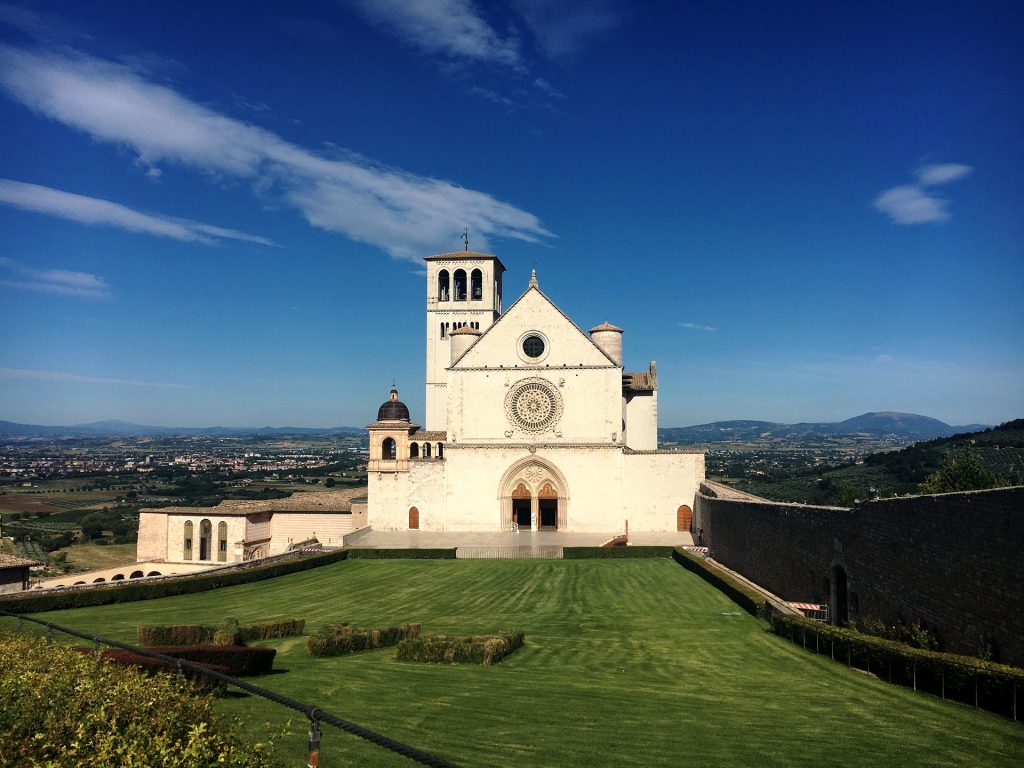
Assisi is a popular pilgrimage site with Christians flocking to view the Basilica di San Francesco sitting on what was previously known as the Colle d’Inferno (the hill of hell). This was the site where criminals used to be executed and buried but it was where St Francis had specifically asked to be buried hence the reason for the location of the church. St Francis is an important figure in the Christian church. St Francis was born in 1181, the son of a wealthy cloth merchant of Assisi. But following a vision of Christ that Francis had in the crumbling Church of San Damiano in which Christ asked him to help him repair his house, he sold his possessions to fund the repairs. His father was incensed and threatened to disinherit him but this simply spurred Francis on. He publicly renounced his family’s wealth, even giving up the clothes on his back and from that moment on lived a simple life in the woods, fields and mountains of Umbria. He was never ordained but following a meeting with Pope Innocent III was given permission to found a new religious order and travelled to Egypt to intervene in the crusades. Here, he so impressed Sultan Melek-el-Kamel that he was allowed to preach to his subjects.
Whatever your religious beliefs, the Basilica di San Francesco is an impressive building, home to some beautiful frescoes and extraordinary stained glass windows which bathe the interior in light. In fact, the basilica is 2 churches, sat one on top of the other – the Basilica Inferiore and the Basilica Superiore. The former is a relatively dark and sombre building building compared to the upper church but it is home to the tomb of St Francis. The tomb was never intended to be on display but the ground around it was dug out in the early 20th century, leaving a central column which houses his body and to where thousands come each year to pay their respects. The Basilica Superiore is filled with light and colour. Make time to admire Giotto’s 28 frescoes which fill the nave and which illustrate the life of St Francis.
Make sure you cover up before heading inside. You will not be allowed in if your skirt of shorts are above the knee and you will also need to ensure that your shoulders are covered too.
There is more to Assisi than just its basilica though, as beautiful and as impressive as this is. The cobbled streets that wind their way uphill are absolutely charming, lined with small boutiques and cafes. However, you will find that prices tend to be rather inflated in Assisi compared to other Umbrian towns. Rest assured, your walk around its streets will be amply rewarded every now and then with impressive views over the surrounding countryside and the valley below.
Other sights worth visiting in Assisi include the Pinacoteca Comunale di Assisi (art galley housing paintings by Giotto and Perugino amongst others) and the Museo e Foro Romano (one of the best archeology collections around, this museum is situated in the Roman forum itself under the town’s central piazza and surrounding streets). A striking site in the main Piazza del Comune is the Church of Santa Maria Sopra Minerva. Its portal is the front section of the ancient Roman temple of Minerva. If you want to visit the site where St Francis had the vision of Christ which changed his life forever, then head to the Porta Nuova and then follow the pretty pathway downhill for around a kilometre until you reach the Church of San Damiano. This is also where the death of the Patron Saint of Television, Saint Clare, is marked. Clare was made the saint by the Pope in 1958 because of a miracle in 1252 when Clare, ill in bed, witnessed a vision of mass being celebrated several miles away.
If you’d like to further follow in the footsteps of St Francis, then head about 4 km west of Assisi to the Basilica di Santa Maria degli Angeli. This is where Francis first came when he gave up his possessions, to a tiny chapel in the woods which survives to this day. It is also where St Francis founded his order of friars and where he died in 1226. It wasn’t until the 17th century that the basilica was built to honour St Francis and, measuring 116 metres long, it’s one of the largest basilicas in the world.
Assisi does get extremely busy with tourists in the peak Summer months. Try and head there first thing in the morning before the coachloads arrive or head later in the day and spend the evening there once the majority of tourists have gone home.
Bettona
Bettona is a charming town that rarely makes its way on to the itineraries of visiting tourists. Whilst it dates back to Roman times, little remains of the original city since it was largely destroyed in the 14th century by the Perugian army. However, it can boast a lovely historic centre, a charming main piazza, two large churches (The Oratory of St Andrew as well as a church built by Benedictine monks in the 15th century in honour of the patron saint of the city) and a museum.
Bevagna

Unlike many of the towns on Umbria’s tourist trail, Bevagna does not sit atop a hill but instead sits in a valley close to the Teverone River. What it does share with other towns is its Roman roots though. Nero’s mother, Agrippina, actually had a villa here and the fertile land around Bevagna meant that it was important agricultural centre. Nowadays it’s quite a sleepy town. Nothing seems to happen fast in Bevagna!
Bevagna’s central square is the Piazza Silvestri and it’s hard to explore the town without always returning to this central space. The town is definitely Medieval but the important exceptions to the Medieval architecture are two Romanesque churches – the smaller San Silvestro built in 1195 and the larger San Michele. Both are worth exploring. Also of interest in the piazza is the 12th century Palazzo dei Consoli, home to the 19th century Teatro Torti. The theatre is a delightful surviving example of the tiny provincial theatres that once flourished in Italy. Visitors need to ask at the Museo di Bevagna to get admittance.
The Museo di Bevagna itself is devoted to telling the history of the village which dates back to Roman times. There are a number of Roman artifacts to view, all of which were found locally. Arguably none of these are as impressive as the black and white Roman mosaic which can be found on the North side of Via Porta Guelfa. The mosaic originally formed part of a bath complex and visitors can glimpse an octopus, lobster and other sea creatures within it.
If you are visiting Bevagna, and enjoy either your wine or your architecture, then it’s worth considering a visit to the nearby Tenuta Castelbuono winery. Sitting a few miles North West of town, it’s easy to spot due to its impressive architecture. Its copper dome, nicknamed ‘Il Carapace’ (the tortoise) was designed by the Italian sculptor Arnaldo Pomodoro. Visitors can enjoy a rather dramatic tasting room that sits beneath the dome as well as enjoying a tour of the cellars below. We recommend booking in advance to ensure availability and to avoid disappointment.
Buzziana
The brainchild of Tommaso Buzzi (1900-1981), Buzziana was the Italian designers attempt to create an ‘ideal’ city, built around the Convent of Scarzuola on land which he bought in the 1950s. The result is clearly inspired by neo Mannerism. The location near the old convent allowed him to blend old and new, whilst the creation itself is divided into seven ‘theatres’. The highest of these is the Teatro dell’ Acropoli which stands above the other six – the Teatro delle Arnie, the Teatro sull’ Acqua, the Teatro della Torre, the Patio Tonde and the Patrio Infinito and the Teatro Sportivo. Stairs crisscross their way across the town, the most notable of which are the Scala Musicale delle Sette Ottave and the Scala di Giobbe, whilst numerous statues decorate the area.
Carsulae
Carsulae is an archeological site dating back to 220 BC. For a small entrance fee, visitors can explore the old Roman remains, some still partially buried. Still visible today are the Curia and Gemini Temples which overlook the Forum (Basilica, Theatre and Amphitheatre). The Church of San Damiano can also be found here. This is actually a church dating back to the Middle Ages that was built on top of the ruins of a Roman edifice.
Cascia

Visitors tend to visit Cascia in search of St Rita. Whilst she may be little known outside Italy, St Rita is widely celebrated among Italian women and thousands visit each year to visit her shrine. For those who have not heard of her, Rita was born in 1381, was forced to marry aged fifteen and then endured 18 years of torment courtesy of her alcoholic husband. Rita lived an exemplary life though, to such an extent that even her husband saw the error of his ways. However, no sooner than he had repented, he died in a brawl and his death was closely followed by that of Rita’s two sons who died attempting to avenge their father’s death. Widowed and childless, Rita became a nun. Within a week of entering the convent, a foul smelling sore developed in the centre of her forehead which was viewed as a kind of stigmata. Rita died in 1457 and after a lengthy campaign finally became a saint in 1900. These days, Rita’s mummified body lies behind grilles within the Basilica of Saint Rita in Cascia.
Apart from the basilica, there is not a great deal to explore within Cascia and over the years the town has been badly affected by a number of earthquakes but it is home to a couple of museums and a couple of other worthy church buildings so it’s easy to spend an hour or so wandering its streets.
Castelluccio
This is a small farming village high up in the Sibillini mountains. For keen walkers, it’s a good base from which to start a hike with trails leaving the village in all directions.
Castiglione del Lago
Castiglione del Lago lies on the shores of Lake Trasimeno and is arguably the lake’s prettiest town. It’s a charming place to visit with a number of food stores selling local Umbrian produce. Stroll along the streets and there will be plenty of opportunities to enjoy free tastings. Or take the time to relax in one of the delicatessens to make a meal of it.
It is possible to visit the town’s fortress – the Rocca del Leone. Visitors can walk all the way round it and up a couple of its towers from where you will be treated to excellent views of the lake. A ticket to the fortress also gets you access to the Palazzo della Corgna, a palace that in its heyday hosted great artists such as Leonardo da Vinci and Machiavelli.
Boats leave regularly from Castiglione del Lago to Polvese and Maggiore, islands in the lake.
Citta delle Pieve
Nestled on the border between Umbria and Tuscany, and sat among fields of bright sunflowers and olive trees, Citta della Pieve was a centre for brick manufacturing in the Middle Ages so it’s perhaps not surprising that the whole town is built from these same bricks. The area around Citta delle Pieve is also known for its saffron, harvested by hand from the crocus blossom.
Citta delle Pieve is the birthplace of Pietro Vannucci (more commonly known as Perugino) in 1446 and home to what locals claim is the narrowest street in Europe – the Vicolo Baciadonne or ‘kissing ladies street’. So narrow is the street that close contact with anyone coming in the opposite direction is inevitable! Visitors can buy a ticket for the Museo Diffuso for just a few euros which allows access to the town’s five main sights the Cathedral, the Palazzo della Corgna, the Oratorio di Santa Maria dei Bianchi (where visitors can admire the Adoration of the Magi, Perugino’s striking nativity scene that he painted in just 28 days), the Chiesa di Santa Maria dei Servi and the Chiesa di San Pietro. All except the palace house works by Perugno.
The town is perhaps more famous for its palio. Whilst it does not rival the fame of the Siena palio nor is it as old founded as it was in the 1960s, the Palio of Citta della Pieve has become a majori tourist attraction. Taking place each August, the palio is between the three districts (terzieri) of the town. The events always begin on Ferragosto (15 August) when the Pallium is returned to the Podesta by the winning team of the previous year. The event itself then goes on for a number of days, culminating in the historical parade to the games field when hundreds of people dress in historical costumes. An archery competition then takes place between the three participants with the most accurate crowned winner.
Another time worth visiting is during the Infiorata held on the closest Sunday to 21 June, when the streets are covered with designs made purely from flower petals to honour the town’s patron Saint, San Luigi.
Or take in a trip to the theatre during your time here. The theatre in Citta delle Pieve is beautiful, adorned with sumptuous satins and velvets and with wonderful private boxes to ensure that your trip here will feel like a really special treat.
Citta di Castello
As you drive to Citta di Castello, you may well come across fields of tobacco plants, since this area is famous for the production of tobacco. You will see evidence of the industry on the outskirts but don’t let this put you off visiting the historic centre.
The historic centre itself is attractive and it’s worth paying a visit to the Pinacoteca Comunale as well as the two museums in town if you plan to spend some time here. The Pinacoteca in the Palazzo Vitelli alla Cannoniera, one of four surviving palaces in Citta di Castello once owned by the Vitelli family. The gallery is laid out over two floors. A couple of its most famous works of art are the Martyrdom of St Sebastian by Luca Signorelli and the processional standard – the Creation of Eve and SS Roch and Sebastian – by Raphael painted in the early 16th century.
The Duomo in Citta di Castello is a rather mixed set of architectural styles, the most recent of which is a Baroque frontage which was begun in 1632 however this was abandoned 15 years later before it was completed. The Museo del Duomo is to the right of the cathedral. Another very different museum in town is the Collezione Tessile di Tele Umbra. This traces the history of textiles in the Upper Tiber Valley but what is most interesting here is what the museum is annexed to – a fascinating textile workshop set up in 1908 by the Franchetti, a local aristocratic family who wanted to provide employment to the local townspeople and to keep alive the linen-making tradition in this area. It’s still in operation today and visitors can buy products made in the workshop as a souvenir to take home with them.
Deruta
Deruta is famous for its ceramics, an industry which has been in the town’s roots since Roman towns but which really came to the fore in the fifteenth century with the discovery of the distinctive yellow and blue glazes and the inspiration from the Moorish designs of Southern Spain. Perhaps not surprisingly, there is a museum devoted to Gubbio’s ceramic past in the old part of the town which houses exhibits from the Roman era to the present day. Of course, there are plenty of opportunities to purchase your own piece of ceramics at one of the numerous roadside stalls and workshops.
Fabro
The Medieval village of Fabro is dominated by its Medieval castle. Unfortunately, over the years the town has sustained damage, most recently in WWII, but it’s still worth a visit, not least in November when the town holds its annual truffle festival. During this time, make sure to try not just the truffles foraged in the woods around the town but also the pecorino cheese flavoured with truffles.
Ferentillo
Ferentillo is a small town with rather a gruesome museum, home as it is to the Museo delle Mummie. This is not a museum for the feint hearted. The museum holds several hundred skulls as well as numerous gruesome naked dead bodies, mainly of which clearly display the reason for death and can have preserved hair, teeth and clothing. The corpses include two French soldiers one of whom was hanged whilst the other was tortured, as well as a bell ringer who died after being knocked off the tower by his own bell, his tongue still between his teeth. All fill the crypt of the Church of Santo Stefano.
Ferentillo is famous for other things though, not least free climbing. The cliffside is one of the most popular climbing spots in Europe and offers routes for all climbers from the beginner to the most experienced. The latest equipment is provided and those free climbers brave enough to scale its heights will be rewarded with stunning views of the Valnerina.
Foligno
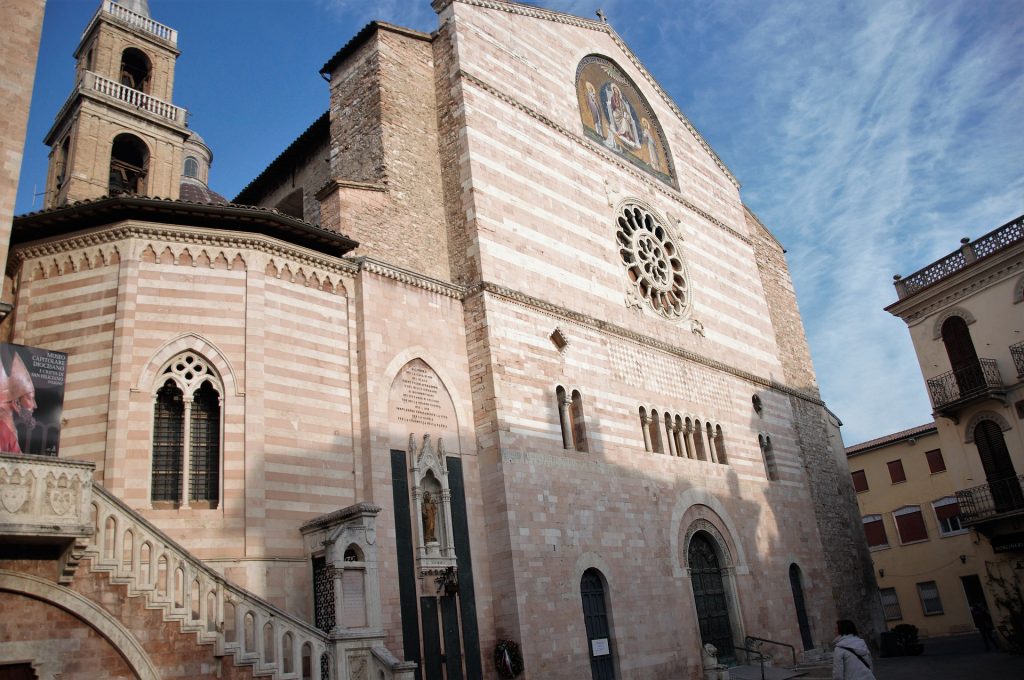
Unlike many of the other towns and cities in Umbria on the tourist trail, Foligno is a much more modern place as unfortunately many of its most impressive sights were bombed during WW2. The third largest town in Umbria, it’s also larger than many of the other visitor spots. More recently, it was also badly affected by the 1997 earthquake when the town’s Torre Communale dramatically collapsed. However, it’s a good destination if you want to enjoy a spot of shopping and even if many of the streets and buildings are more modern, the central Pizza della Repubblica with it’s eye catching Duomo, is beautiful.
The city plays host to one of the most spectacular festivals in Umbria – the Giostra della Quintana. There are two opportunities to see it each year. The first tournament takes place on a Saturday night in June and the second (the counter challenge) takes place on the second or third Sunday in September. Both feature a jousting tournament in which ten horsemen (one for each of the city’s wards) compete to speer their lances into an ever decreasing sized ring. Both events are followed by a lively festival with Medieval parade and the whole thing is colourful and exciting.
But, of course, Foligno plays host to food festivals too, notably the ‘First Courses of Italy’ each September and October when top chefs, food critics and manufacturers from all over Italy converge on the city to celebrate Italy’s most famous foodstuff – pasta! And let’s not forget any music lovers out there. Foligno has a popular jazz festival each June – ‘Young Jazz’.
If you do head to Foligno, then we can recommend a bite to eat at either Villa Roncalli or Cucinaa. Just outside the centre, the latter doesn’t perhaps look like anything special from the outside, wedged as it is in a parade of shops, but we love the concept behind it and it offers great quality food, perfect for a relaxed bite to eat en route to your next stop. Villa Roncalli is more formal and is set within a hotel. The dishes incorporate the produce from the chef’s extensive vegetable gardens.
Gualdo Tadino
Gualdo Tadino is a hill top town famous for its ceramics industry and each Summer it holds a big exhibition devoted to the craft. It also boasts a Gothic Duomo, and eighteenth century Palazzo Comunale and the Palazzo del Podesta. Unfortunately it did sustain damage during the 1997 earthquake.
Gubbio
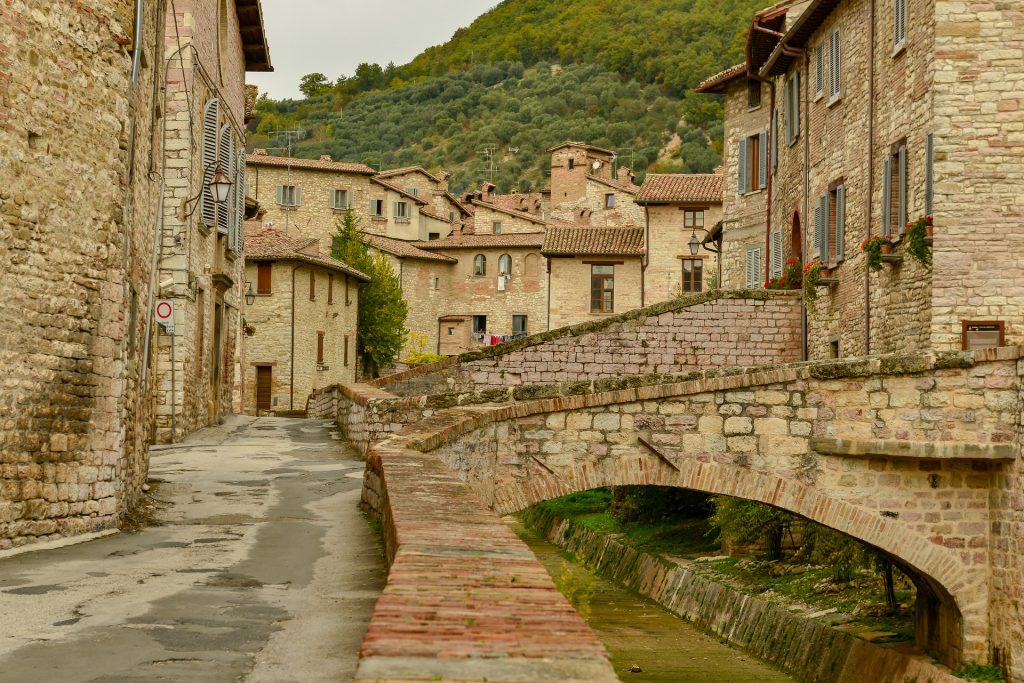
Gubbio is a beautiful Medieval town, sometimes described locally as the ‘Umbrian Siena’. It’s also affectionately known as the ‘city of fools’. According to legend, if you run around the fountain three times, you will earn the ‘fool’s license.’ However, it has an equally fascinating, albeit tragic, modern history too. In 1944, forty innocent civilians were murdered in one of its central piazzas by the Nazis as reprisal for partisan attacks in the surrounding hills. The square was since renamed Piazza Quaranta Martiri as a result.
This piazza is home to the Gothic Church of San Francesco and opposite this is the Loggia dei Tiratori. This is a long passageway covered with a terrocotta tiled roof and supported by stone columns. It was originally built by wool merchants who used the building as a place to stretch wool and cloth in the shade of its arches, the gaps between which allowed air to circulate and kept it cool.
Also worth a visit are the Palazzo dei Consoli, the Museo Civico (home to Umbria’s most important archaeological find, the Eugubine Tablets), the Pinoteca and Museo Archaeologico, the Palazzo Ducale, Museo Diocescano and Duomo.
If visiting in May, try and time your visit to coincide with the Corsa dei Ceri (Race of the Candles) on 15 May. This must be one of Italy’s craziest races. Running over 4 km and mostly uphill, it consists of a number of processions through the town before culminating in a race to return the candles to the hilltop Basilica di Sant’ Ubaldo (which is where they had been taken from earlier in the day!) Not that anyone but the cero of Ubaldo has a chance of winning…. there are strict rules and the cero of Ubaldo can not be overtaken! Even if you can’t make it for the Corsa dei Ceri, either climb or use the cable car to reach St Ubaldo’s Basilica which host the remains of the Saint and the famous Ceri throughout the year.
Or if visiting in the Summer months, check to see if your visit coincides with any events at Gubbio’s Roman amphitheatre. At 112 metres wide, it’s one of the largest surviving Roman amphitheatres and it makes for a wonderful setting for various plays and performances.
Lake Trasimeno

Lake Trasimeno is Italy’s fourth biggest lake however it is under threat from climate change. Fed almost entirely by rainwater, water levels have fallen in recent years and it risks drying up entirely in the future.
There are two islands within the lake. The largest , quietest and arguably most attractive of these is the Isola Polvese. The island is a carefully protected nature reserve that is home to around 6000 olive trees and oak woods. In Medieval times, it would have been home to around 500 people, all of whom would have made a living through fishing. However, nowadays it is uninhabited. Guided tours of the island are possible but visitors can equally explore alone too. Take a walk around the island and you will come across the Fortezza Medievale. Whilst the origins of the fortress date back to the 13th century when it was much needed by the locals to provide protection from attack, nowadays it’s used as a venue for concerts as part of the popular Trasimeno Blues Festival. The second building on the island – the Monasterio di San Secondo – served a very different purpose, home to monks who inhabited the island from the end of the 15th century. Head to the north east of the landing point on the islands and you will discover a beach area.
The second of the lake’s islands – the Isola Maggiore – is much more developed with a range of shops and restaurants as soon as holidaymakers step off the boat. Boats run 12 times a day throughout the year from Passignano to the island.
The lake’s most popular town is arguably Passignano, which is attractive and has a vibrant air about it. It can get extremely busy in the peak Summer months though. Other lakeside towns and villages worth exploring around the lake include Castel Rigone and Castiglione del Lago. The former is a charming village, filled with geranium strewn balconies in the Summer months whilst the latter has is a pretty town filled with food stores and boasting a couple of pleasant beaches from which to rest and enjoy the sunshine.
Magione
There may not be much to draw you to a visit to Magione however for racing enthusiasts, it is home to one of Italy’s smallest racing circuits.
Marmore Falls (Cascata delle Marmore)

The Marmore falls are among the highest man-made waterfalls in Europe. With a total drop of 165 metres, the falls were created by the Romans but even today remain the tallest man-made waterfalls in the world.
There are a number of different walking routes to take to view the falls. All involve a number of steps and narrow pathways so be sure to wear sensible footwear. For this reason, it may be unsuitable for the very young, elderly or infirm. If you fancy the route which goes via the ‘Lovers Balcony’, then bring a waterproof jacket with you…. you are bound to get sprayed by the water.
Please note that it’s worth visiting at certain times to be sure that you witness the falls in action. They are controlled by the Galleto hydroelectric plant which releases water only at certain times in the day. It does get busy too. Make sure you buy your entrance ticket from the main ticket office before heading to the falls.
If you enjoy water sports, the river around the falls is an ideal spot for rafting, canoeing and kayaking and there are a number of companies offering these sports.
Marsciano
Marsciano was historically a major brick manufacturing centre and is home to the Museum of Brick Making and Terracotta. Visitors will learn about the traditional brick making tradition as well as have the opportunity to view more decorative, everyday pottery ware.
There is more to the town than its museum though. Make sure you get the chance to admire the painting done by the School of Perugino in the Church of San Giovanni Battista, the 19th century Palazzo Comunale and the Teatro della Concordia as well as a number of Art Deco buildings and the Palazzo Battaglia, adorned with decorations by the futurist painter, Gerardo Dottori.
Montefalco
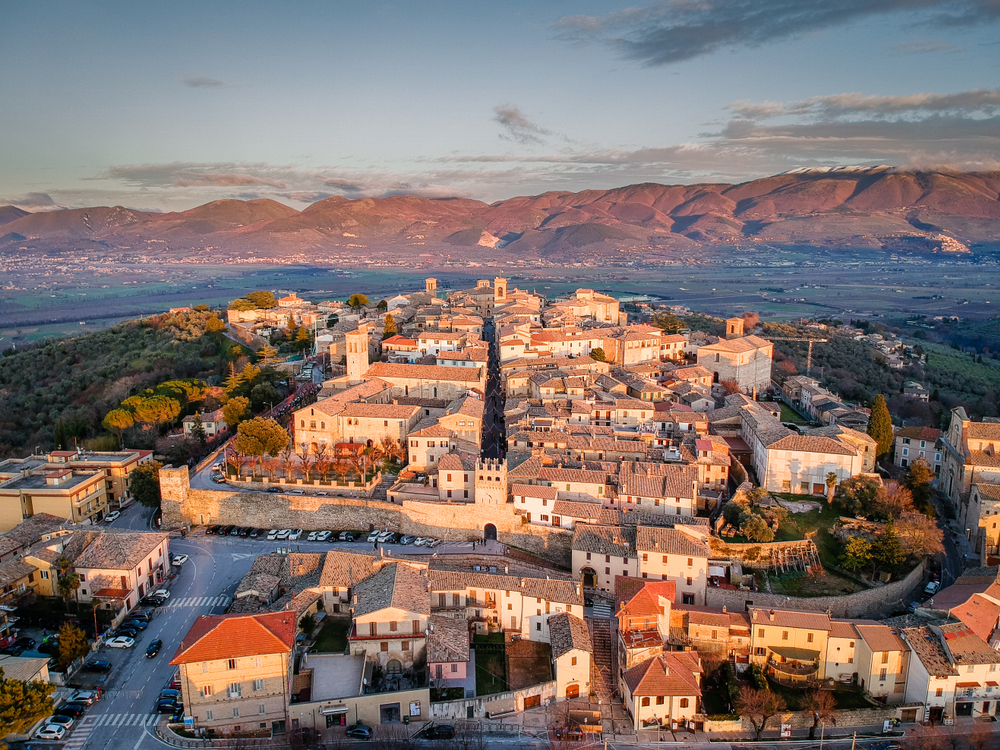
Montefalco is commonly known as ‘the balcony of Umbria’ due to its lofty position. The town itself is a warren of narrow cobbled streets, all of which are too narrow for cars. It’s a very pretty place and whilst it’s won’t take you long to explore its streets or it’s central piazza – Piazza del Comune – there are a few sights worth seeing. These include the church of San Francesco and its museum. The church is home to an impressive series of frescoes by Benozzo Gozzoli called the ‘Life of St Francis’. Other artworks can be found in the museum upstairs.
For wine lovers, head to the town in late Summer when Montefalco plays host to a major wine festival each September – the Settimana Enologica (Wine Week) – where visitors can sample the many wines produced in the region. These include the Montefalco Rosso and Sagrantino. The latter is a dry red wine. We can definitely recommend you try the Sagrantino Passito typical of this region. It’s a sweet red dessert wine and is absolutely delicious!
Montegabbione
Montegabbione is a Medieval walled hilltop village. Noteworthy sights in the village include the fifteenth century tower which marks the entrance to the village as well as the 17th century Church of Madonna delle Grazie nestled just outside the village walls and which is home to a beautiful fresco depicting the Madonna del Latte.
Monte Sibillini
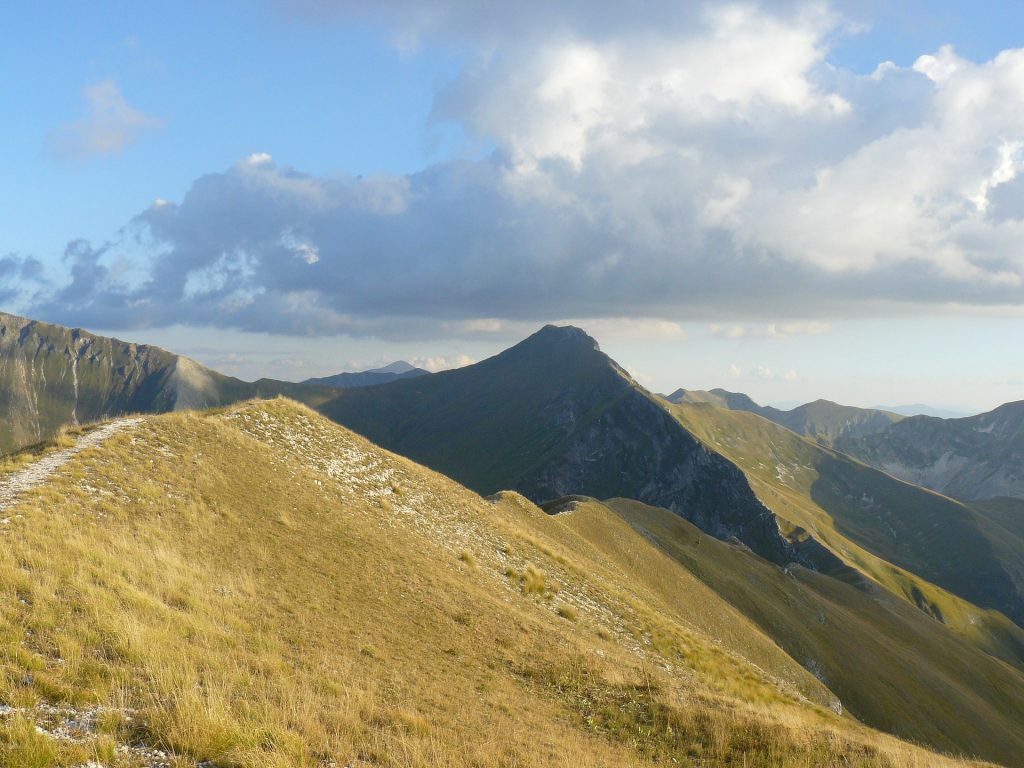
The Sibillini mountains fall across Tuscany and Umbria and the whole area is a national park. If you’re a keen hiker, then walking doesn’t get much better than here. There aren’t many marked trails but it is possible to get details of some through the Club Alpino Italiano (CAI).
Monte Subasio
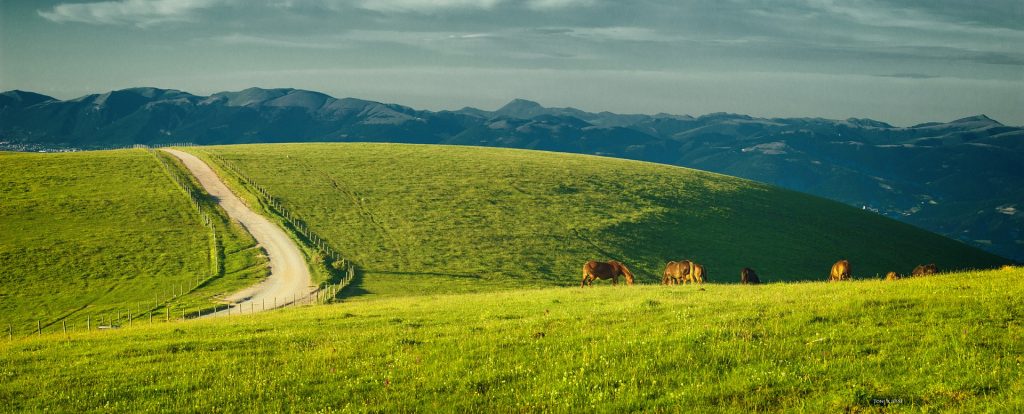
Rising high above Assisi, Monte Subasio is snow covered for much of the year. It’s popular with paragliders and a great place for hikers to admire the astonishing views below. Paragliders have five different take-off areas to choose from on Monte Subasio as well as two different landing areas, both of which can easily be reached by car or bus. For walkers and cyclists there are a number of different paths and trails to choose from dependent on how long and how strenuous you would like the walk to be.
Montone
Montone is a delightful hilltop village. Whilst it doesn’t feature on many tourists’ bucket lists, it is well worth a visit. One of the ‘borghi piu belli d’Italia’ (most beautiful villages in Italy), there is certainly much to fall in love with, from the narrow cobbled streets to the colourful flowers that festoon the balconies.
Visit at certain times of the year and you can also join in the many annual events that the village plays host to. These include the popular ‘Donazione della Santa Spina’ held each August when the three districts of Montone compete to win the palio and the Lady of the Castle. Those taking part will dress in Medieval costumes and bring the past back to life. Also well worth a visit is La Festa del Bosco which celebrates the woodland harvest. Stalls, shops and restaurants will all celebrate the very best of the local produce including mushrooms, truffles, chestnuts, berries and honey.
Narni
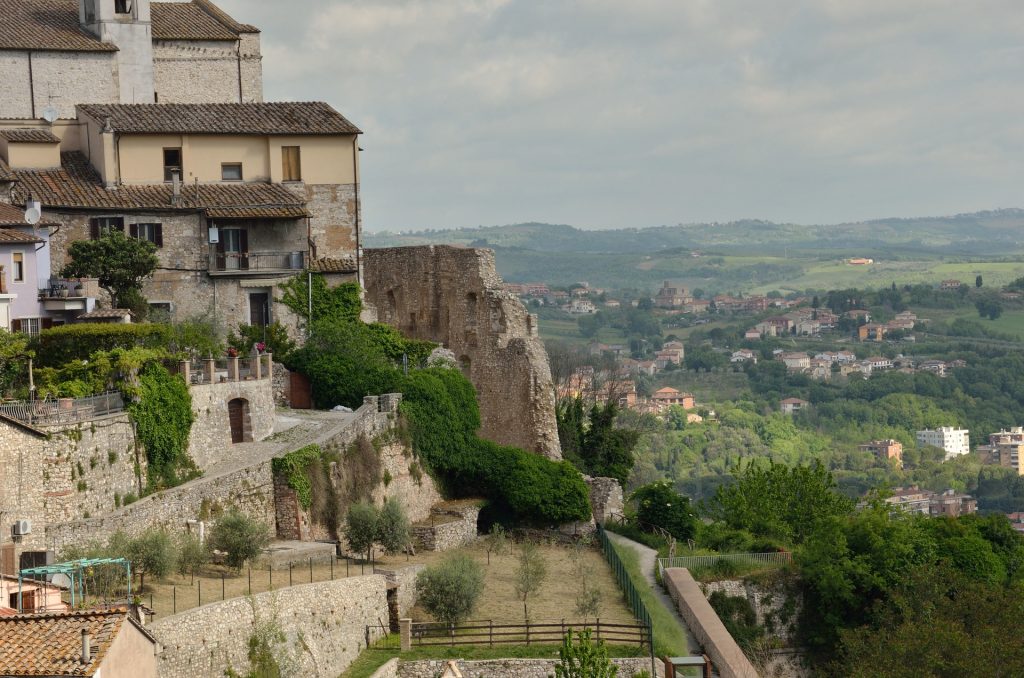
Narni is a charming hill top town. Its Duomo is certainly worth a visit as is its two palaces – Palazzo dei Priori and Palazzo del Podesta – but we think that one of the most interesting sights in the town is Narni Underground. This is a fascinating hour long tour of the aqueducts, cisterns and secrets of the Inquisition hidden underground in Narni. Entering via the church of San Domenico, the tour starts in what was once St Dominic’s convent, moves into a large room which is probably the remains of a Roman house and then into a dark room which was the Tribunal of the Inquisition and where accused heretics were placed on trial. The suffering and pain endured by those on trial here can be seen in a small cell covered with the graffiti and markings of those kept there whilst awaiting their fate whilst an exhibition showing the instrument used to inflict torture leaves nothing left to the imagination.
The town’s main festival is held each May. Two weeks of festivities lead up to the Corsa dell’ Anello which includes a torchlight procession and jousting festival when contestants from the three Medieval quarters of the town compete to get their lance through a ring (anello) suspended in Via Maggiore.
Just outside Narni’s centre sits the Rocca Albornoz and Ponte di Augusto. Not much is left of the bridge today but the solitary 30m high arch that is left is rather beautiful in itself and leaves it to the imagination of the spectator to re-create in their mind the 160m length bridge that once existed. In contrast, the castle is very much in tact and looms over Narni. Surrounded by parkland, its a very pleasant spot for a picnic or rest in the sunshine and a great place to admire the views over the surrounding countryside.
Further out again are the ancient ruins of Oriculum. The ancient ruins here are impressive, the most well preserved of which are the theatre, amphitheatre and Capitolium.
Norcia
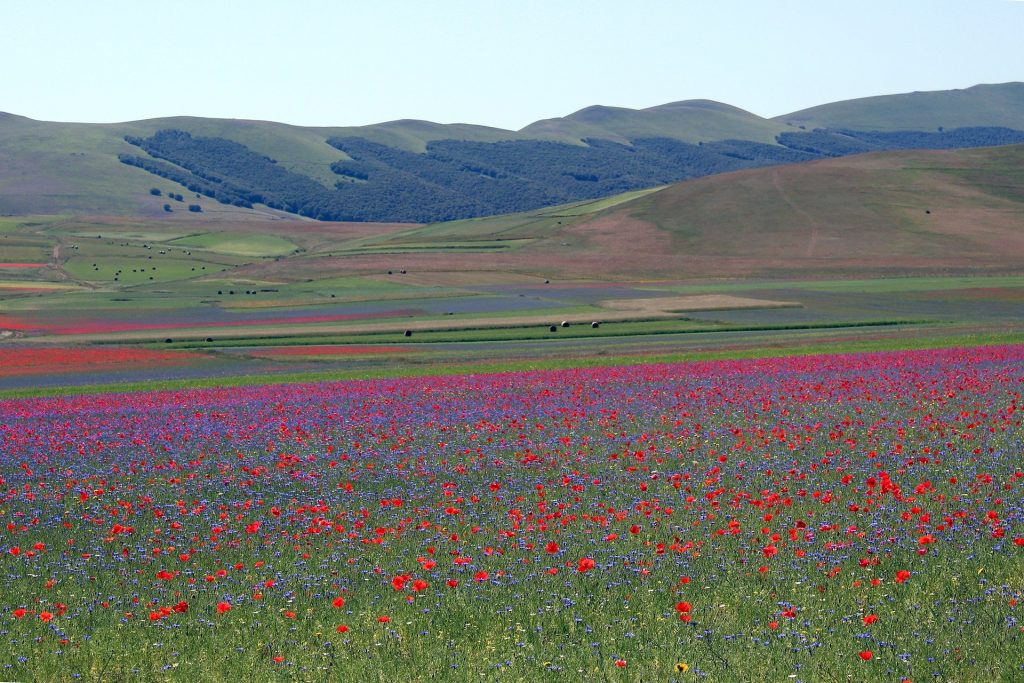
Norcia is a beautiful walled town but, unfortunately, it has been plagued by the threat of earthquakes for many years. Due to historic tremors, a law was passed in 1859 which forbade any buildings above 12.5 metres in height. However, this failed to prevent damage in subsequent earthquakes, the most damaging of which were in 1979 and more recently on 24 August 2016. Unfortunately, the latter completely destroyed the Medieval Basilica of St Benedict along with several other buildings. The process of rebuilding will take years and is still very much work in progress but don’t let this put you off visiting. The town has a real vibrancy and buzz about it.
Foodies will fall in love with Norcia, home as it is to its famous salami, black truffles and wild boar. Numerous shops along Norcia’s streets will offer the opportunity to try some free samples. However, if you want to try samples of the best that the town has to offer, we recommend lunch at Norcineria Ansuini Brothers. The shop itself is a sight to behold but they offer a few small tables outside where you can enjoy their wares on sight. Worst case, head here to stock up on provisions for dinner!
We highly recommend you visit in the Spring, combining a trip to the town with a trip a little further into the hills to view the spectacle on the plains of Castelluccio 1453 metres above sea level. In the Spring months (and most typically in June but the exact date of flowering can obviously vary), the wild flowers bloom with a multitude of colours and the result is truly breathtaking. Not surprisingly, the spectacle attracts a number of flower lovers from all over the world. It’s the most magical spot to enjoy a walk or to go trekking and is not to be missed.
If you can’t make it to Norcia to see the Spring flowers, then try and coincide your visit with one of the food festivals instead. The main truffle season runs from January to April and the last two weeks of February sees a dedicated truffle festival. This has become a renowned international event where visitors can enjoy the famous black truffles of Norica as well as a whole host of other foods including capocollo, ricotta and other cheeses, proscuito and salame. Or the 3 day Proscuiti al Mondo festival, featuring prosciutto producers from all over Italy, starts on 1 November each year.
Or for something more based in history, head to Norcia at the end of March or end of August. At these times Norcia celebrates its patron saint, Benedict. Visitors to Norcia at that time will be treated to a display of music, dance and shows in the main piazza along with a historical parade with participants dressed in Medieval costumes and competing in an archery contest.
Orvieto
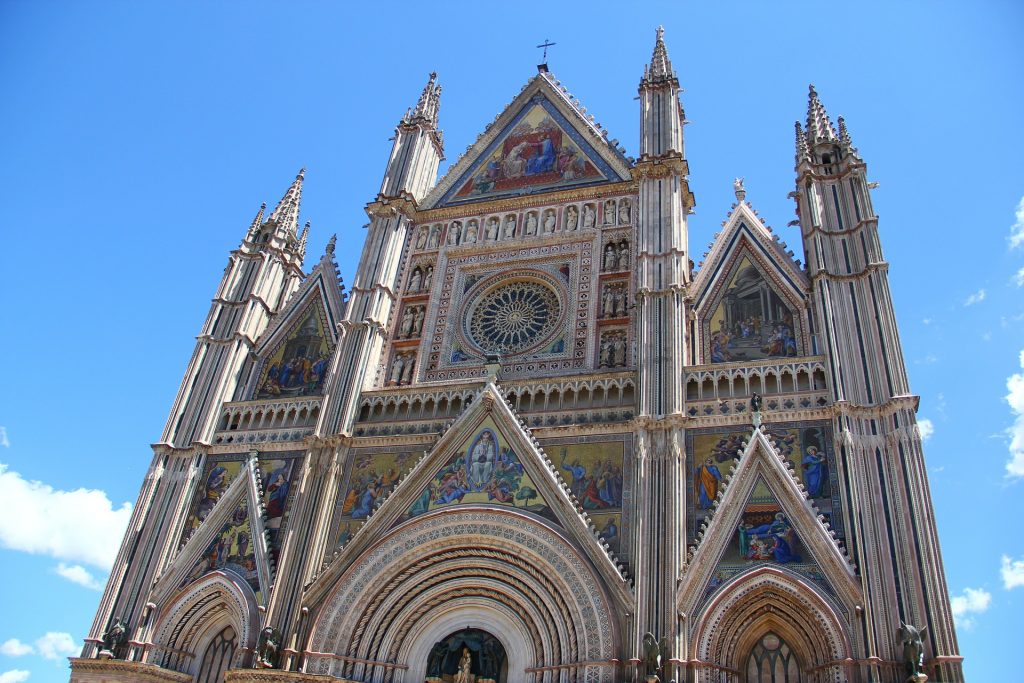
Orvieto is a beautiful town, filled with charming narrow streets, independent shops, stunning churches, interesting museums, historic palaces and as rich a history to explore underground as above ground.
First and foremost, Orvieto’s Duomo is an impressive spectacle and is arguably one of the greatest Gothic buildings in the whole of Italy. Inside, there are some beautiful frescoes by Luca Signorelli whilst its facade is just stunning.
Other sights of interest include the Museo Claudio Faina, the Museo Archeologico Nazionale and the Museo dell’ Opera del Duomo. The first of these is perhaps the most interesting.
But don’t miss out on the opportunity to explore what is under your feet. The Grotta della Rupe is an extraordinary series of caves, cellars, aqueducts, quarries and tunnels. In total over 1200 caves have been discovered and it’s possible to enjoy a tour of some of these to learn more about its rich history. Also underground is ‘Il Labirinto di Adriano’, a series of caves, wells and underground rooms that were so named thanks to the owners Adriano and Rita who discovered it in the 1970s. Also heading deep underground are a couple of wells – the Pozzo della Cava and the Pozzo di San Patrizio. Both are open to visitors and the latter has an ingenious spiral staircase design that ensures you won’t get clogged in pedestrian traffic as you make your way up and down!
For a completely diferent view of Orvieto, make your way to the Torre del Moro. Visitors can climb its many steps to a spectacular terrace where you can enjoy 360 views over Orvieto and beyond.
Adjacent to the Torre is the Palazzo dei Sette, one of a few palaces in Orvieto, another being the Palazzo del Popolo.
Orvieto also has a rich theatrical tradition and visitors may like to see if anything is on at the Teatro Mancinelli.
Paciano
Not far from the shores of Lake Trasimeno, Paciano is a perfectly preserved Medieval village, enclosed by thick 14th century walls and entered via one of three gates. There are a number of churches in the village as well as half a dozen restaurants. It is also home to a well-kept secret – a fantastic bakery open twice a week.
Panicale
Panicale is a pretty hill town, enjoying views towards Castiglione del Lago and over Lake Trasimeno itself. If you’re an art lover, then take a look in the Church of San Sebastiano where you will find a couple of Perugino paintings.
Papiano
Papiano is a small village and home to one of the most noteworthy bell towers in Umbria. One of five watchtowers of the ancient 13th century castle built here, it is made entirely of stone and has a prominent clock dating to the 13th century along with two bells. The village is a fascinating place for a stroll, with a myrid of tunnels, arches, alleyways and frescoes to explore.
Passignano sul Trasimeno
Passignano is arguably the most popular town on Lake Trasimeno. But be warned, it can get extremely busy in the peak Summer months and traffic tends to build up through its streets. The Rocca del Passignano dominates the town and its worth a visit, if only to climb the spiral staircase in its tower to reach the terrace 32 metres up. The climb will reward you with wonderful views over Lake Trasimeno and the surrounding hills.
Visitors to the fortress will also come across the Boat Museum which houses a range of boats and equipment all used in their day for fishing on the nearby lake and on the other Italian inland waters. These include ‘fassoi’ wich are boats made with lake plants and used in Sardinia as well as boats typical of the Padule di Fuceccio in Tuscany. One of the oldest exhibits is a mono-sail boat, a boat dating back to 1200 that was created out of the trunk of an oak tree and found in Passignano.
Perugia
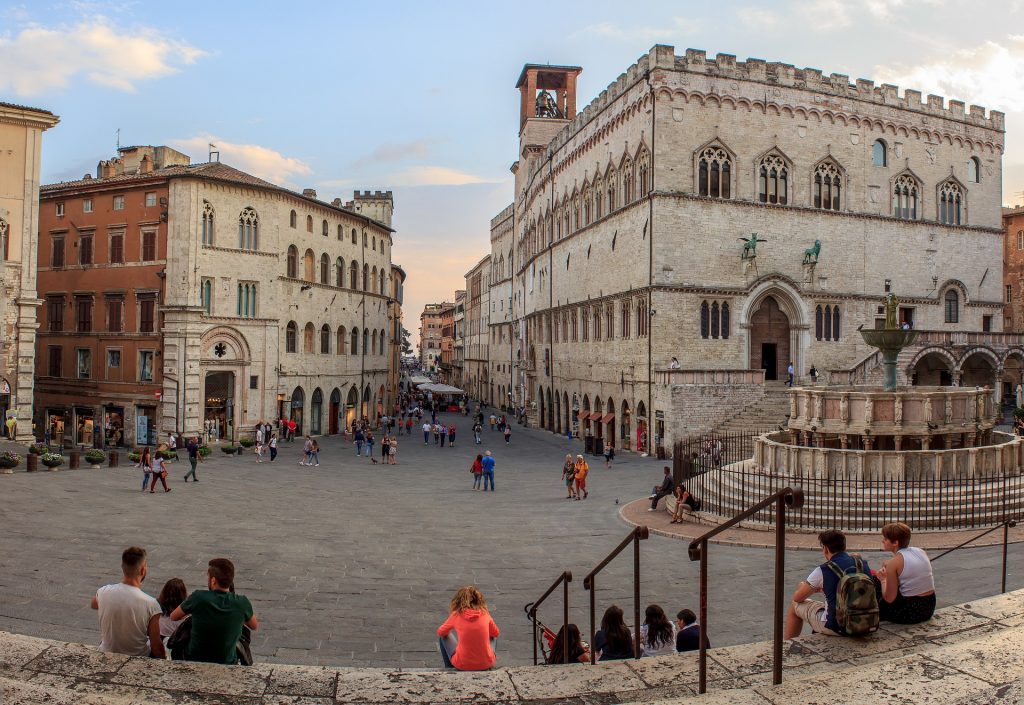
Perugia is the capital of the Umbria region. It’s also an important university town and its thriving student population gives the city a buzz whatever time of year you choose to visit. Many people choose to fly into it’s small airport – Sant’ Egidio – and then don’t even manage to visit but it’s certainly worth a trip.
The city’s main street is the Corso Vannucci. This is a wide pedestrian street filled with shops and cafes, at one end of which lies the Piazza IV Novembre and at the other the Piazza Italia. The street is named after Perugia’s most famous artist, Pietro Vannuccci, more commonly known as simply Perugino. The Piazza IV Novembre is home to both the Palazzo dei Priori and the Duomo whilst in its centre sits the beautiful fountain – Fontana Maggiore. The latter was designed in 1277 by the Silvestrine monk, Fra’ Bevignate and sculted by Nicolo and Giovanni Pisano.
The Palazzo dei Priori has an imposing Gothic doorway and rows of trefoil windows. It is home to 4 key sights, all worth a visit – the Sala dei Notari (a Medieval lawyers meeting hall dating from the 1290s), the Sala del Collegio della Mercanzia (the seat of the merchants guild), the Collegio del Cambio (the hall of moneychangers whose walls are adorned with frescoes by Perugino) and finally the Galleria Nazionale dell ‘Umbria (a stunning art gallery which traces the artwork of Umbria from Byzantine times through to the Renaissance period when focus falls heavily on both Perugino and Pinturicchio and then beyond through to the nineteeth century).
The city also has a number of other important museums well worth visiting. These include the Museo dell’ Opera del Duomo which is accessed through the cathedral sacristy and the Museo Archeologico Nazionale dell’ Umbria.
And, as with most Italian cities, there are also a number of beautiful churches. The Duomo is, of course, worth a visit as is the church of San Severo in Piazza Rafaello. This contains one of Raphael’s first complete works – A Holy Trinity and Saints (1505-8 and 1521). Also worthy of mention is the stunning interior of San Pietro and the ancient rotunda of Sant Angelo as well as the smaller churches of SS Severo e Agata, San Filippo Neri and Santi Stefano e Valentino. The afore mentioned rotunda of Sant Angelo is one of the oldest churches in Umbria and was probably built on the site of a Roman temple.
The city plays host to a number of festivals throughout the year. These include Umbria Jazz in July, Music Fest Perugia across both July and August and Eurochocolate in October. Umbria Jazz is certainly Italy’s most important jazz festival. In the past it has seen jazz greats such as Miles Davis and Stan Getz perform.
There are also some regular markets in the city. There is a flower and terracotta market every weekend in the Piazza Danti whilst for foodies, there is a permanent covered food market (Mercato Coperto) just off Piazza Matteotti which opens every morning with the exception of Sundays. In addition, a more general market operates every Tuesday and Saturday mornings on the Scala di Sant’ Ercolano.
Piediluco
Piediluco is a small village on the North shores of the Lago di Pediluco, famous for being a sailing and canoeing centre. The lake itself boasts a few small beaches but it’s certainly not the best lake in the region for swimming in with rather murky waters.
San Feliciano
This is a sleeping but charming fishing village set on the Eastern shores of Lake Trasimeno. It’s possible to catch a ferry from here to Isola Polvese. It’s a nice place to spend an hour whilst waiting for the boat. Enjoy a drink in one of the lakeside cafes whilst looking out over the traditional flat bottomed fishing boats and watching the fishermen mend their nets.
San Gemini
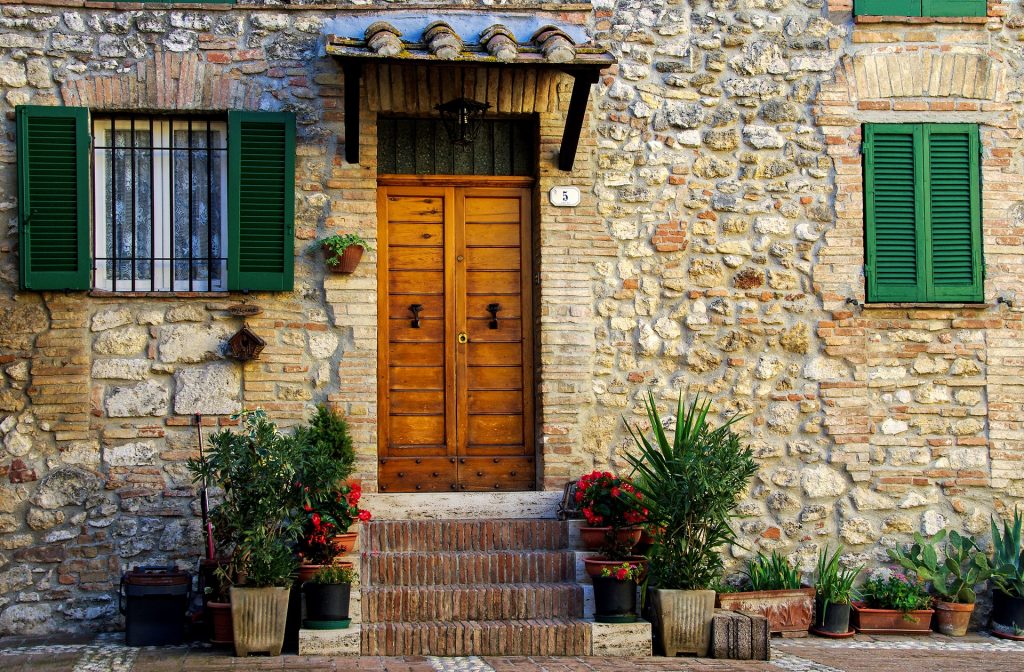
San Gemini is a spa town with a Medieval centre, renowned for its mineral springs. For centuries, the natural springs have had a reputation for their healing properties and many visit the thermal spa each year
There is plenty more on offer in San Gemini though. The Medieval town centre has a number of key sites worth visiting including the Gothic style Church of San Francesco located in the Piazza San Francesco at the heart of the town, the Palazzo Vecchio which is home to some beautiful frescoes and, adjacent to this, the Torre Esperia, with its bell tower built in 1318 as a way to call the town to meetings. Also of note is the Duomo of the Church of San Gemine dating back to the 12th century and again home to some beautiful frescoes as well as the relics of Saint Gemini, as well as the Church of San Carlo and the 11th century Abbey of San Nicolo.
As with many of the towns and villages in Umbria, San Gemini also has some key annual events that it celebrates. These include the Infiortata di San Gemini held around May or June when the city is decorated with flowers. Residents create real works of art using flower petals and herbs. It is a spectacle not to be missed.
More regularly, San Gemini also hosts an antiquity market every third Sunday of the month. This is an ideal chance to pick up a priceless antique as well as modern day crafts and draws visitors from all over Italy.
Spello

Probably our favourite towns in Italy, Spello is a Medieval hilltop town. Unlike many of its neighbours in Umbria, its main piazza is nothing special, bordered as it is on two sides by modern 20th century buildings. The town invested considerably in the square in 2017 but the modern buildings remain. And in any case, the rest of the town more than makes up for this.
In May, Spello hosts the Infiorata of Corpus Domini which is an incredible spectacle. The local residents put together the most stunning works of art within the streets of the town using only flower petals and leaves. Prizes are awarded for the best creations, all of which are started at the same time on the Saturday and which the artists work through the night to complete. Not surprisingly, accommodation in the town gets booked up early for this time of year, as people look to witness the beautiful artworks for themselves.
In the Summer, Spello remembers its Roman roots. Hispellum, as it was called in Roman times, was an important Roman centre. At the bottom of the town, excavations have revealed an old Roman villa which has now been carefully preserved within a modern 21st century museum. There are hands-on exhibits for children to enjoy making it a suitable stopping point for all the family. Other Roman remains within the town include the Porta Consolare (the main gateway at the bottom of the town), the Porta Venere (arguably the most impressive of the gateways sitting to the West of the main piazza) and the Arco dei Cappuccini or Porta dell’ Arce at the top of the town. From here, you can look down on to the ruins of the Roman amphitheatre.
At the end of August each year, Spello celebrates the period of time in the fourth century AD when, under the reign of Constantine, the city enjoyed real prestige, becoming the Roman federal capital. Across 4 days at the end of Summer, the glorious Roman past is re-enacted with shows, parades, battle simulations, banquets and more. It’s not unusual to be sat enjoying an evening aperitif and to see a Roman centurion or soldier walking past or a Roman lady fully kitted out in her beautiful toga.
Spello’s churches are also worth a visit. Situated in the Piazza Matteotti is the Chiesa di Santa Maria Maggiore which are home to Pinturicchio’s frescos in the Capella Baglioni. The nearby Church of Saint Andrea also houses another Pinturicchio masterpiece – the Madonna and Child with Saints.
The town is famed for its excellent restaurants. Our favourites include La Bastiglia at the very top of the town. The setting here is superb. Ask for a table with a view outside on the terrace and you won’t be disappointed. Or in the centre of the town there is La Cantina, serving delicious Italian cuisine in a fantastic atmosphere. For an unforgettable wine tasting experience, try Enoteca Properzio, a family run business whose owner, Roberto, knows everything there is to know about wine and whose choice of wines is second to none.
Spoleto

Spoleto was an important Roman colony and has remained of importance to this day. It is a thriving bustling centre and it’s also incredibly beautiful. The town can be split into an Upper and Lower section. The majority of the architectural sights are in the higher area as the lower section was heavily damaged during WWII and subsequently rebuilt by the Allies but there are nevertheless three important Romanesque churches in the lower section which are worth visiting. These are the churches of San Salvatore (one of Italy’s oldest churches located within the town’s main cemetery), San Gregorio and San Ponziano.
There is much more to see in the Upper Town, the heart of which is the Piazza della Liberta and the Pizza del Mercato. At the South end of the square is the Arco di Druso, a first century Roman arch whilst adjacent to the arch is the Church of Sant’ Asano. Head inside for a glimpse of the crypt which is adorned with frescoes dating back to the 6th century AD. The other end of the piazza leads to the Church of Sant’ Eufemia. It is unique in Umbria thanks to its matroneum (womens gallery). This sits above the body of the church and is reached from a tiny door on the left on the left aisle. It served to segregate the congregation – the women would sit upstairs and the men downstairs. When visiting the church, leave some time to also visit the Museo Diocesano d’Arte Sacra, home to many artefacts and paintings from churches across the region.
The Piazza del Mercato itself gives you a real sense of how the locals live. There is a market held here every morning (except Sundays) and it’s not unusual to see locals washing fruit and vegetables in the central fountain. Certainly, you’ll always find locals here sitting to chat and swap stories in the local bars and cafes around its edges.
There is less to see in the Piazza della Liberta but there is a restored Roman theatre which is used for performances throughout the year as well as the Museo Archeologico. A combined ticket provides entry to both.
If you are interested in Roman history then you may also want to explore the Casa Romana (Roman House). Excavated between 1885 and 1912, the house supposedly once belonged to the mother of the Emperor Vespasian.
A short walk from the Piazza Mercato is the Duomo. It’s a beautiful building, with a real sense of elegance. Some of the most famous works it houses include Fra Lippo Lippi’s ‘Life of the Virgin’ and Pinturicchio’s unfinished work of art, the ‘Madonnna and Child with the Baptist and St Stephen.’ But you will also be walking on one of its most beautiful features – the stunning original marble floor.
If you’re more into shopping than art and architecture, then head to Corso Mazzini which is home to most of Spoleto’s shops.
Or if you simply want to wander around its streets and take in its beauty, add a short walk to the Ponte delle Torri to your route. This is a spectacular 14th century aqueduct and is probably the town’s most famous attraction. It spans 240 metres supported by 10 enormous arches, the highest of which measure 76 metres. Take a walk across to the pathways on the other side which lead into some beautiful woods and on to olive groves.
En route over the bridge, you will spot the Rocca (castle). This was originally built as part of an attempt by Cardinal Albornoz to restablish the authority of the church but in succeeding years has been anything from a Papal holiday home to a prison. Nowadays it is possible to enjoy a tour of the castle, our favourite part of which is the wonderful views that it affords over the surrounding area.
Spoleto also has a wonderful Summer festival – the Festival dei Due Mondi (Festival of Two Worlds), a contemporary arts jamboree and one of the leading arts festivals in Europe held every June and July. It has been going since it was created by composor Gian Carlo Menotti in 1958 and has a vast array of concerts to enjoy in many genres including opera, dance and drama. It also includes a number of interesting discussions.
Terni
Terni is a rather ugly, industrial city with little to recommend it to visitors. It was a centre for steel manufacturing in the 19th century and this emphasis on industry led to it being heavily bombed by the allies in WWII.
It does boast two claims to fame – St Valentine was born here (although lovers will find little to delight in here) and it was also where the gun was made that was used to shoot John F Kennedy. For those looking to find out more about Valentine, head to the Basilica San Valentino where you will find his tomb. His remains are kept in a glass case under the main altar here and encased in a gold death mask.
Otherwise, there is not a great deal to see. Terni’s Duomo is rather unusual in that it looks more like a civic palace than a religious building and adjacent to this are some Roman remains but there is not much more. That said, it hosts a good performing arts festival each year and does have an excellent contemporary art gallery.
Todi

Todi’s Piazza del Popolo is often described as Italy’s most perfect Medieval piazza, flanked on each side by palaces and a beautiful Duomo. It’s certainly the heart of the city and home to many of its most important sites. Not surprising given its beauty, it has been the set for a number of films, most notably Cleopatra featuring Elizabeth Taylor. You’ll probably come across her photo in a number of the town’s bars and restaurants!
The Duomo was built in the 13th century on the site of an old Roman temple. It has an incredibly simple, almost plain facade but don’t let this deceive you. The interior is worth exploring. Take a look at the copy of Michelangelo’s Last Judgement on the far wall but don’t expect to be too impressed by it! Ferrau da Faenza’s copy is pretty poor! You will no doubt find the altar more impressive, designed and built by Gianncolo di Paolo, one of Perugino’s followers. There is plenty to be seen underground here too. For a small additional fee, you can explore the underground crypt.
There is more to be found underground in Todi. The Piazza del Popolo itself was built on top of a series of Roman cisterns. Visitors now have the opportunity to see these for themselves. Just look for signs to the Cisterne Romane.
The palaces in the Piazza del Popolo were originally built by the commune to try and out-do the church. They include the Palazzo dei Priori, the Palazzo del Popolo and the Palazzo del Capitano. The latter is home to the Museo Etrusco-Romano which, as the name suggests, contains a number of important local Etruscan and Roman artefacts.
A couple of other places sights worth visiting include the churches of Santa Maria della Consolazione, one of the best Renaissance churches in Italy, and San Fortunato. Here it’s possible to climb the 153 steps of the church tower to enjoy some fantastic views over Todi to the countryside beyond.
And of course, the views alone are worth the trip to Todi. Todi is set 410 metres up enjoying views down over the Tiber valley. For some of the best views head to Piazza Garibaldi.
Try and time your visit to coincide with the Todi Festival held each year at the end of August or beginning of September. The festival is a 10 day extravaganza of music, ballet and arts. Or head in on any Saturday during the year and your trip will coincide with the weekly market. Another important market that is worth seeing is held in the last week in March in the Piazza Comunale in Todi. At this time, antique dealers from all over Italy converge in the square to sell a variety of antiques including furniture, ceramics, rugs and paintings.
Trevi
Visitors can spend a couple of hours enjoying the labyrinth of narrow streets that make up Trevi’s centre. The town is also home to a couple of museums, notably the Pinacoteca Comunale in the former Convcent of San Francesco and the Museo della Civilta dell’ Ulivo, which in contrast to the focus on artworks in the Pinacoteca is instead devoted to the history and production of olive oil. It’s perhaps not surprising to find a museum to the latter here, surrounded as Trevi is by miles and miles of olive groves.
Umbertide
Unfortunately Umbertide was heavily bombed during WW2, leaving little of its old roots left to see and meaning that its Medieval centre is absolutely tiny, albeit charming. The rest of the town is more industrial and there isn’t much to keep tourists entertained for long here. That said, there is a museum just outside the old town walls – the Museo di Santa Croce di Umbertide – which is home to Luca Signorelli’s ‘Deposition’.


